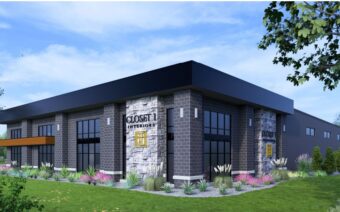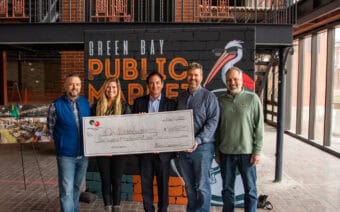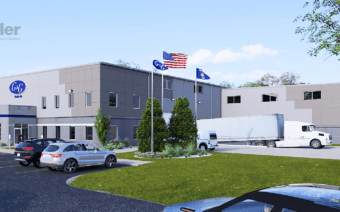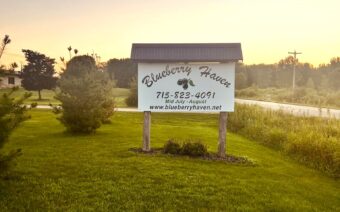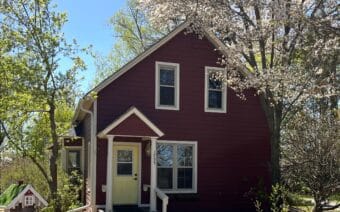
July 15, 2024
GREEN BAY – With the shortage of affordable housing in Brown County and the need to help veterans transition back into a community, Veterans 1st of Northeast Wisconsin (NEW) – a nonprofit agency providing support for area veterans – is doing its part to try and help.
“I’m a veteran, and I was a hospital corpsman in the Navy taking care of Vietnam vets – that was dear to my heart,” Gail Nohr, co-founder/secretary of Veterans 1st, said. “I worked 22 years in the post office and then six years at the county veteran service office – I was taking phone calls from veterans in need of housing and services.”
Gail said when her husband, Kim Nohr (co-founder/president of Veterans 1st) retired as a carpenter/home builder, they decided they needed to do something.
Though Veterans 1st does way more than build tiny homes for veterans in need, Gail said that has become the most recent focus of the organization.
“After three phases of construction, we will have 21 tiny homes within a veterans’ village,” Gail said. “We will also have a community center with an office, kitchen and meeting area to be shared by all veterans, our residents and community members. All of our training will also take place there.”
The couple said the village will sit on 3.5 acres in the northeast part of Green Bay off St. Anthony Drive right next to Veterans Manor.
Gail said Veterans 1st has eight part-time and full-time staff members.
The homes
Gail said the project includes 17,400-square-foot tiny homes under fair market value rent and four 600-square-foot, two-resident rapid rehousing tiny homes.
“Residents must agree to a behavior contract, and the village will have more than 12 cameras for monitoring,” Gail said. “Staff will be available from early morning until evening. Squad leaders will be monitoring residents from evening until morning.”

Kim said it’s important to first give veterans a safe, secure home.
“After that, it’s about putting them in a community where they feel supported – it goes hand in hand,” he said. “Getting veterans safe and secure is the first step.”
Gail said seven homes will be built each year, with an end completion date sometime in 2026.
“Our goal is to help veterans become self-sufficient in five years,” she said. “Four of the homes will be 30% of their income for rent for up to two years. After two years, they should be able to move into one of the 17 affordable rent homes. The rent would be under fair market value with the ability to obtain a Housing Choice Voucher or VA (veterans affairs) voucher that would pay up to 70% of the rent and allow them to get health care and case management services.”
After five years of living in the village, Gail said Veterans 1st has two agencies that will help veterans apply for a VA home loan, with no money down and low interest.
“If they want to stay longer, they could apply to be a squad leader and help the six residents in their squad after staff leaves for the day,” she said.
Kim said the first seven tiny houses are already paid for.
“Some of the people/organizations are willing to donate substantial amounts of money,” he said. “The homes cost $50,000 each, and some are $100,000.”
For the remaining 14 tiny homes, Kim said they’re still applying for grants and other federal funding.
“Just because the homes are small, that doesn’t mean they can’t be attractive,” he said.
Kim said the project’s first seven tiny homes will look similar, with small differences.
“We’ll mix up the colors and that type of thing – we’ll have three different colors,” he said. “I would like to switch up the elevation view a bit to get more of a mix… We don’t want the houses to be cookie-cutter.”
Kim said the Veterans 1st tiny houses will be fixed structures.

The smaller models feature:
- Covered, zero-step entries
- Separate living and bedroom spaces
- Walk-in showers
- Stoves, microwaves and refrigerators
- Air conditioning
The larger models feature:
- Two covered, zero-step entrances
- Separate living and bedroom spaces
- Full bathtubs
- Laundry rooms with a washer and dryer
- Stoves, microwaves and refrigerators
More than tiny homes
Gail said Veterans 1st is doing “much more than simply building tiny houses.”
“We offer so much more – we work with 75 partner agencies,” she said. “Veterans 1st partners with eight employment agencies, including the Wisconsin Workforce Development to offer opportunities for meaningful employment. We are also partnering with the VA Clinic, the Vet Center and many other healthcare agencies to address our residents’ healthcare needs.”
Gail said the mix of agencies the nonprofit works with offer a variety of services and resources.
“Veterans 1st has three agencies that want to hire veterans on the spot,” she said. “We also have 11 health and wellness services and eight different financial assistance agencies we work with.”
Gail said Associated Bank will offer financial literacy classes on-site.
“We’ve got another agency that wants to donate coffee pots and other small appliances for (residents) to take with them (when they move on),” she said.
Gail said therapy services will also be offered to help support veteran residents on their journey to self-sufficiency and housing stability.

“We will work with Brown County and the Vet Center to offer counseling and therapies to our veteran residents who might be struggling with different traumas,” she said.
Certified peer specialists and veteran mentors, Gail said, are also available.
“They want to work with our veterans to help them overcome their issues and teach our veteran residents how to be peer specialists and recovery coaches,” she said. “After addressing wellness issues, we are partnering with the Department of Workforce Development’s Veterans Services and Disabled Veterans Outreach Program to provide our residents with relevant job training and placement in a career they are interested in.”
Some of the other services Veterans 1st offers, Gail said, include:
- Art therapy offered by veteran volunteers
- Woodworking classes offered by Kim Nohr
- Raised garden boxes and in-ground plots offered by the UW Extension for veterans to work in and get paid for
- Cornerstone Mortgage and Movement Mortgage will be helping residents with VA Home Loans and finding a home after five years
- Dog and horse therapy
- Monthly cookouts and camaraderie with local veteran groups and organizations
- Spirituality sessions offered by local pastors weekly for support
- Fishing and hunting trips offered for residents who are 30% or more disabled
- Massage therapy for pain
- Movement/meditation groups
- AA and other 12-step groups
“It’s crazy,” she said. “We have probably more than 200 people on our volunteer list, along with the 75 agencies. We want to be an asset to the neighborhood.”
For more on Veterans 1st, visit veterans1stnew.com.
 Appleton International Airport expansion on schedule for 2025 NFL Draft
Appleton International Airport expansion on schedule for 2025 NFL Draft Renovo Health offers affordable health care through traditional options
Renovo Health offers affordable health care through traditional options


